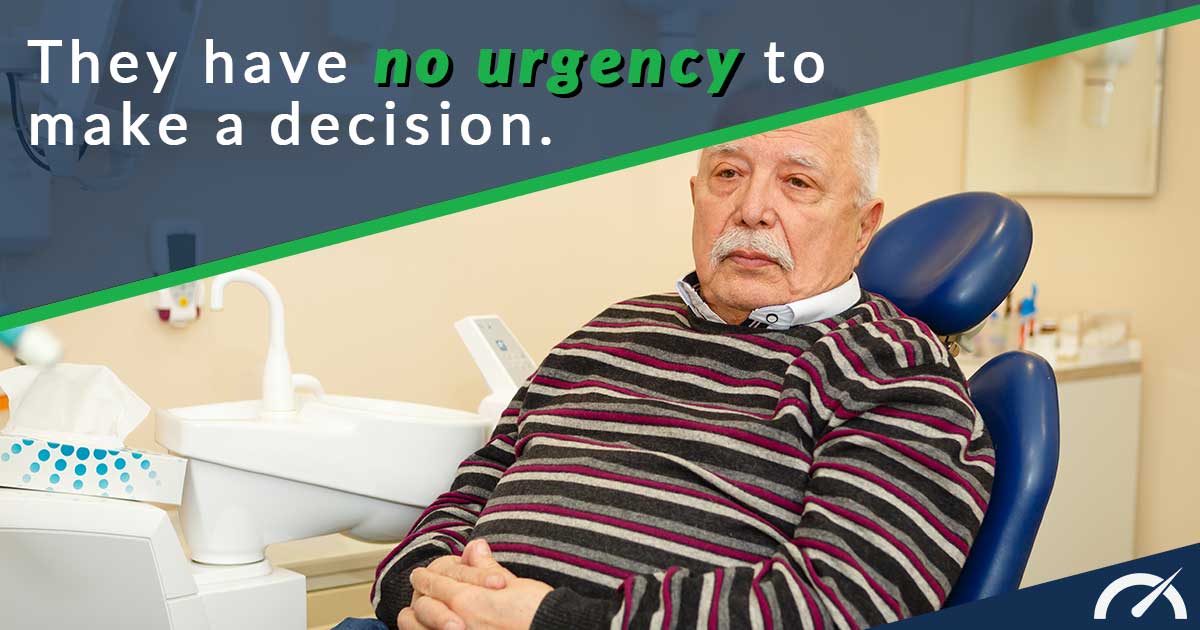If you don’t know why patients are saying no, you can’t help them say yes. That’s the bottom line when it comes to case acceptance. You can try all the case presentation strategies you want but none of them will work unless you understand why patients say no.
Here are the top five reasons patients say no when you present your treatment plan. Understanding these can help you get over the five biggest obstacles to patients saying yes.
1. Their mindset or emotions hold them back.

Generally speaking, people’s mindsets fall into two categories: scarcity and growth. Scarcity minded people see the world’s resources as limited. They see their future success as having a ceiling through which they will never break. Anything you present to them will be received in that context by a scarcity-minded patient.
If you present a high-value treatment plan to them when they are in a scarcity mindset, they might not believe they deserve that treatment and say no. Presenting treatment as more of a necessity than a luxury could help them move forward with the treatment they need could help. You can also work to shift their mindset to become more growth-minded over time. A scarcity-minded person will have a big emotional shield to moving forward with something they believe to be.
Growth-minded people see their future as limited only by their actions. They see others succeed and think they could succeed if they took action. They are much more likely to be proactive about moving forward with a treatment plan that helps move them toward a better future.
2. You haven't built enough trust with them.

Your case acceptance will only be as strong as your relationship with your patient. Take the time to get to know your patients. Make sure your team members or intake managers show interest in them, as people.
By doing so, your patient will be much more likely to trust your treatment recommendations and move forward with your treatment plans.
3. You give them too many choices.

Give your patients two or, at most, three options for treatment. Otherwise, you will overwhelm them with choices and they will be much more likely to say no. The excuse they give will likely be that they want to do research or talk with their spouse. But the reason underlying that excuse is they become overwhelmed and don’t believe they can make the right decision.
STOP GENERATING LEADS, GET PATIENTS INSTEAD
Stop chasing unqualified leads and wasting your valuable chairtime. Learn how to fill your operatories with patients who are pre-qualified and serious about moving forward with your high-value treatment.
4. They have no urgency to make a decision.

Patients are much more likely to move forward with treatment when there is an urgent reason to do so. Whether it is a medical emergency or a promotion you are running, some urge to move forward right away will get more patients to say yes to the treatment they need.
5. They are confused by the options.

When someone is confused, the easiest answer is to say “no” because it keeps the status quo. If patients don’t understand one or more of their options, they will not feel comfortable moving forward with your treatment plan. Even if they understand one option, but not the other, they will say no because they won’t know whether they are making the right decision for themselves.
Be crystal clear about which option you believe is the best choice for them and why. Tell them in layman’s terms how each decision will impact their life.
Are too many patients saying no to your treatment plans?
If so, one of these reasons might be holding them back. For additional reading, also check out six science-based principles to influence your patients to say yes.
